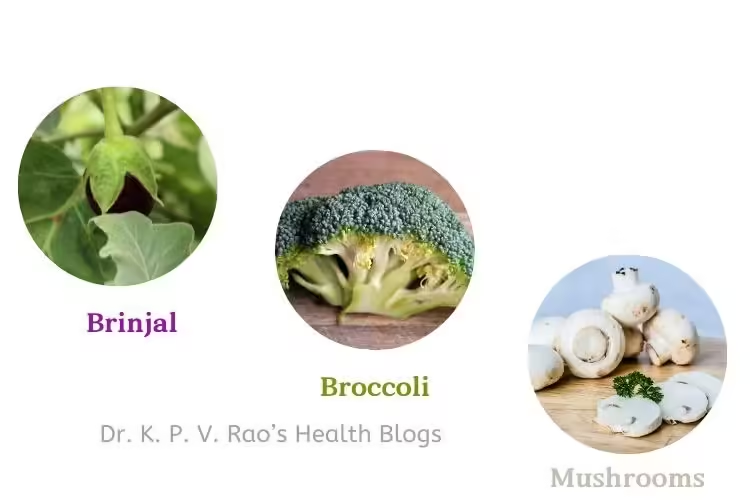Introduction:
In my last article on olive oil, I mentioned that I will be writing about some food items that disrupt our health. Since we are discussing some things that we eat, I thought that it would be better if we discussed 6 popular vegetables and their usefulness in our diet.
While reading my articles you must have noticed that I focus on what best we can do to improve and maintain our health. I like to share what I do to keep me healthy, be it exercise, my dietary choices or medications.
In this article I am sharing 6 such vegetables that I use regularly in my diet. These 6 vegetables are:
- Broccoli
- Brinjals
- Mushrooms
- Cucumbers
- Tomatoes, and
- Spinach.
A note should be made here- even though these vegetables I mentioned above have good effects on our health, they also have some drawbacks- and this is what I intend to do- discuss both in detail.
As this article is quite exhaustive, I have split it into 2 parts. In Part 1 I will take you through Broccoli, Brinjals and Mushrooms; in Part 2, Cucumber, Tomatoes and Spinach.
Why should we learn about this?
From boosting immunity and supporting cardiovascular function to understanding concerns about substances like goitrogens, solanine content, and oxalates present in some popular vegetables, this article will you through with valuable insights and preparation tips to help you make informed dietary choices. So, stay tuned and let’s get going!
Before we see the details about pros and cons of eating these vegetables, I would like you to see a few nutritional facts of these six vegetables in approx. 100 grams of the vegetable-
| VEGETABLE | CALORIES | CARBOHYDRATES | PROTEINS | FATS | FIBERS | |
|---|---|---|---|---|---|---|
| BROCCOLI | 55 | 11.2g | 3.7g | 0.6g | 5.1g | |
| BRINJAL | 25 | 6g | 1g | 0.1g | 3g | |
| MUSHROOMS | 15 | 2.3g | 2.2g | 0.2g | 0.7g | |
| CUCUMBER | 16 | 3.6g | 0.7g | 0.2g | 0.5g | |
| TOMATOES | 18 | 3.9g | 0.9g | 0.2g | 1.2g | |
| SPINACH | 23 | 3.6g | 2.9g | 0.4g | 2.2g |
Let’s get started-
Broccoli: Pick of vegetables
Nutritional Powerhouse with Some Caveats
Broccoli stands out as one of the most nutrient-dense vegetables available. It is rich in vitamin C, K, and fiber, so it offers a substantial boost to our immune system and supports heart health.
Additionally, broccoli contains an array of antioxidants, including sulforaphane, which play a crucial role in reducing oxidative stress and potentially lowering the risk of chronic diseases. It also contains other antioxidants like Lutein and Zeaxanthin that are beneficial to our health.
However, despite its numerous health benefits, broccoli is not without its drawbacks. One notable concern is its goitrogen content.
Goitrogens are naturally occurring compounds that can interfere with thyroid function by disrupting the production of thyroid hormones. This can be particularly problematic for individuals with existing thyroid issues, such as hypothyroidism. For such individuals, moderate consumption of broccoli is advisable, and it is recommended to consult with a healthcare provider for personalized dietary advice.
Another consideration is the potential gastrointestinal discomfort associated with high fiber intake. Broccoli’s significant fiber content, while beneficial for digestive health and bowel regularity, can also lead to bloating and gas for some individuals.
This is especially true for those who are not accustomed to a high-fiber diet. To mitigate these effects, introducing broccoli gradually into the diet and ensuring adequate hydration can be effective strategies.
Optimal preparation methods can also play a significant role in maximizing the nutritional benefits of broccoli while minimizing its drawbacks.
Steaming is often considered the best method to preserve its vitamins and antioxidants. Boiling, on the other hand, can lead to a significant loss of nutrients. Lightly sautéing with a small amount of healthy oil can also be a viable alternative, offering both flavor and retention of essential nutrients.
Incorporating broccoli into a balanced diet can offer numerous health advantages, provided its consumption is tailored to individual health needs and dietary preferences. By understanding both its benefits and potential drawbacks, one can make informed choices about including this vegetable in their diet.

Brinjals (Eggplants):
Versatile but Potentially Problematic
Brinjals, also known as eggplants, are celebrated for their nutritional richness and culinary versatility. These vegetables are a valuable source of dietary fiber, which aids in digestion and helps maintain a healthy gut.
Moreover, eggplants are packed with essential vitamins and minerals, including vitamin C, vitamin K, vitamin B6, and potassium, all of which contribute to overall health and well-being.
One of the standout benefits of eating eggplants is their high antioxidant content. Notably, they contain nasunin, a potent antioxidant found in the vibrant purple skin of the vegetable. Nasunin has been shown to protect brain cells from oxidative stress, potentially playing a role in the prevention of neurodegenerative diseases.
Additionally, the presence of chlorogenic acid in eggplants offers anti-inflammatory and antimicrobial properties, further enhancing their health benefits.
However, it is important to be aware that eggplants belong to the nightshade family, which also includes tomatoes, peppers, and potatoes.
Nightshades contain alkaloids such as solanine, which, in high concentrations, can be toxic and may exacerbate conditions like arthritis in some individuals. The solanine content in eggplants is generally low, but those with sensitivities should exercise caution.
To mitigate potential adverse effects, proper cooking techniques are essential. Cooking eggplants thoroughly can reduce the levels of solanine and other alkaloids, making them safer to consume. Methods such as roasting, grilling, or baking not only enhance the flavor but also help in breaking down these compounds.
Additionally, salting eggplants before cooking can draw out some of the bitter compounds, further reducing any risk of irritation.
Watch this video of a mouthwatering, tasty and healthy recipe using both olive oil and brinjal:
In conclusion, brinjals are a nutritious and versatile vegetable with numerous health benefits, particularly for digestion and brain health. However, individuals sensitive to nightshades should be mindful of their consumption and employ proper cooking techniques to enjoy eggplants safely.
Mushrooms: Nutritional Benefits and Allergic Reactions
Mushrooms are a distinctive category of vegetables that offer a myriad of nutritional benefits. They are particularly rich in vitamins B and D, which play crucial roles in energy metabolism and bone health respectively.
Additionally, mushrooms are a substantial source of selenium, a powerful antioxidant that aids in combating oxidative stress and supporting immune health. The presence of various antioxidants, including ergothioneine and glutathione, further enhances their anti-inflammatory properties, contributing to overall well-being.
Types of mushrooms
There are several types of mushrooms commonly consumed, each offering unique health benefits.
For example, Shiitake mushrooms are known for their immune-boosting properties, while Portobello mushrooms are praised for their high potassium content, which supports cardiovascular health.

Maitake mushrooms, often referred to as “hen of the woods,” are celebrated for their potential to regulate blood sugar levels
Despite their nutritional advantages, mushrooms are not without potential drawbacks. A small percentage of individuals may experience allergic reactions when consuming mushrooms. Symptoms can range from mild, such as skin rashes and itching, to severe, including difficulty breathing and anaphylaxis.
It is crucial for those with known food allergies to exercise caution and consult healthcare professionals before adding mushrooms to their diet.
Gastrointestinal issues are another concern for some people. Mushrooms can be difficult to digest, leading to symptoms like bloating, gas, and stomach discomfort. This is often due to the presence of chitin, a fibrous substance found in their cell walls.
To overcome these side effects, it is advisable to cook mushrooms thoroughly, as this can make them easier to digest and reduce the likelihood of gastrointestinal distress.
Incorporating mushrooms into your diet safely involves starting with small quantities and observing any adverse reactions. Cooking mushrooms thoroughly and experimenting with different types can also help you identify which varieties are best suited to your dietary needs.
By taking these precautions, you can enjoy the numerous health benefits of mushrooms while minimizing potential risks.
Useful article:
- 15 Of the most nutrient dense foods
- Chefs Reveal Why Mushrooms Taste Better At A Restaurant Than At Home
To be continued…
Here I come to the end of Part 1 of the article where I discussed the first 3 of the 6 popular vegetables. Stay tuned in for the next part by subscribing to my notifications by tapping the bell icon. Do share this article with your friends and family members. You can also Tweet here on X-
The Benefits and Drawbacks of Eating these 6 Popular Vegetables Share on X
Adios.